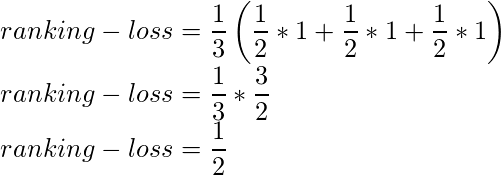MultiLabel Ranking Metrics – Ranking Loss | ML
Last Updated :
23 Mar, 2020
Ranking Loss is defined as the number of incorrectly ordered labels with respect to the number of correctly ordered labels. The best value of ranking loss can be zero
Given a binary indicator matrix of ground-truth labels

The score associated with each label is denoted by

where,

Ranking Loss can be calculated as :

where

represents number of non-zero elements in the set and

represents the number of elements in the vector (cardinality of the set). The minimum ranking loss can be 0. It is when all the labels are correctly ordered in prediction labels.
Code: Python code to implement Ranking Loss using the scikit-learn library.
import numpy as np
from sklearn.metrics import label_ranking_loss
y_true = np.array([[1, 0, 0], [0, 1, 0], [0, 0, 1]])
y_pred_score = np.array([[0.75, 0.5, 1], [1, 0.2, 0.1], [0.1, 1, 0.9]])
print(label_ranking_loss(y_true, y_pred_score ))
y_pred_score = np.array([[0.75, 0.5, 0.1], [0.1, 0.6, 0.1], [0.3, 0.3, 0.4]])
print(label_ranking_loss(y_true, y_pred_score ))
|
Output:
0.5
0
In the first sample of the first prediction, the only non-zero label has ranked in top-2 values. similarly for the second and third samples. All have only one non-label in the ground truth label.

By putting these values in the formula we get,

In the second print statement, All the ground truth label corresponds to the highest value in the predicted label. Hence, the ranking loss is 0. We can also got the same answer when we put those values in the formula because the rightmost term for each sample is
0.
References:
- Tsoumakas, G., Katakis, I., & Vlahavas, I. (2010). Mining multi-label data. In Data mining and knowledge discovery handbook (pp. 667-685). Springer US.
Like Article
Suggest improvement
Share your thoughts in the comments
Please Login to comment...